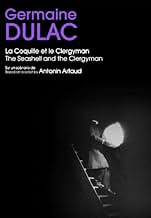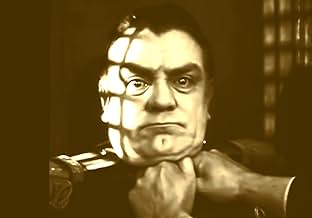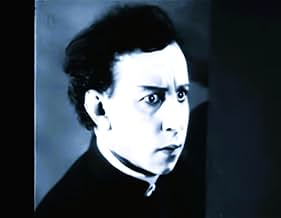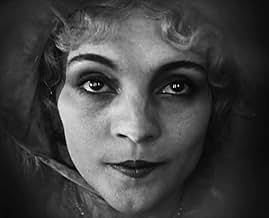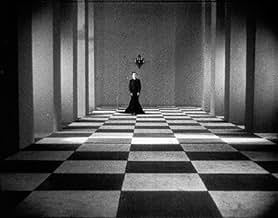La coquille et le clergyman
- 1928
- 40min
NOTE IMDb
7,0/10
2,4 k
MA NOTE
Obsédé par la femme d'un général, un ecclésiastique a d'étranges visions de mort et de luxure, luttant contre son propre érotisme.Obsédé par la femme d'un général, un ecclésiastique a d'étranges visions de mort et de luxure, luttant contre son propre érotisme.Obsédé par la femme d'un général, un ecclésiastique a d'étranges visions de mort et de luxure, luttant contre son propre érotisme.
- Réalisation
- Scénario
- Casting principal
Avis à la une
Germaine Dulac has created a monster here... Not in any kaiju sense, but by taking a surreal swipe at just about every element of the masculine-driven, religiously flawed environment of the world in the 1920s. The eponymous priest - Alex Allin harbours none too subtle desires about the mistress of "le général" (Lucien Bataille) - the beautiful Genica Athanasiou, and the next half hour illustrates some of the complex ramifications of this infatuation. Now I have watched this many times, each time thinking as I get older, that the penny may drop and that I shall discover a deeper meaning... Each time, I thoroughly enjoy the intimate, creative imagery and the truly characterful performances, but am still really none the wiser. I think that's what is enthralling about this short enigma of a feature. It stimulates questions, but doesn't answer any of them... Clearly, the director has an agenda, and a political point to make - but we are left to imagine a healthy amount of what this might be about. Is it erotic? Is it about frustration, excess...? I still don't really know....
Germaine Dulac was no ordinary French female film-director. She was Avante-Garde and radical in her film-making which did not include a laugh track or sound. Everything was visual and her silent classics were visuals to be appreciated and understood by all of us. There was a reason that so many people saw the same movie numerous times during that era. First, it was very inexpensive and second, you needed to revisit and see the film again and again until you saw it completely. That's how films once were, films were visual masterpieces and in Dulac's case, she helped reshape the role of women in films to include more than just being an actress. She was the producer, director, and writer. She was many things to many people on film sets in France. Film was new and fresh invention that those of us who seek to learn more about art should watch Dulac's classic.
Stumbled upon this on Wikipedia:
quote: The British Board of Film Censors famously reported that the film was "so cryptic as to be almost meaningless. If there is a meaning, it is doubtless objectionable"
I wonder if the fact that this was the work of a female director influenced people of that time to dismiss the importance of this particular piece.
Just with a little research we can find Dulac's political views about gender, thus for me is quite clear the intention behind this film, and perhaps we can have second guesses about the symbols used in it, but her questioning the church, the state and male sexuality and the positioning of women at that time was groundbreaking. Which is sad, because if not but that huge dismissal, this could be catalogued easily as the very first surrealist film of all times, BEFORE Buñuel-Dalí's 'A Chien Andalou' and don't get me wrong I enjoyed it, but even Buñuel stated that he didn't put any meaning behind it, it was just a dream put into film so why the double standard?
Loved the ideas behind The Seashell and the Clergyman, it was great to bump into this film, for it was an amusing discovery!
quote: The British Board of Film Censors famously reported that the film was "so cryptic as to be almost meaningless. If there is a meaning, it is doubtless objectionable"
I wonder if the fact that this was the work of a female director influenced people of that time to dismiss the importance of this particular piece.
Just with a little research we can find Dulac's political views about gender, thus for me is quite clear the intention behind this film, and perhaps we can have second guesses about the symbols used in it, but her questioning the church, the state and male sexuality and the positioning of women at that time was groundbreaking. Which is sad, because if not but that huge dismissal, this could be catalogued easily as the very first surrealist film of all times, BEFORE Buñuel-Dalí's 'A Chien Andalou' and don't get me wrong I enjoyed it, but even Buñuel stated that he didn't put any meaning behind it, it was just a dream put into film so why the double standard?
Loved the ideas behind The Seashell and the Clergyman, it was great to bump into this film, for it was an amusing discovery!
If you are looking for a twin movie to go alongside Luis Buñuel's surrealist head-scratcher Un Chien Andalou, then look no further than this film. The Seashell and the Clergyman shares that famous movie's bizarre, often indecipherable, imagery as well as anti-clerical subversion and frank sexuality. I can't say I understood what was going on. I'm not sure if I was even supposed to. But like Buñuel's film this movie is all about surrealism, it doesn't always have logical meaning. An image such as the clergyman crawling through the streets of Paris is something that is not easily forgotten and the film in general operates in the same way as a dream. The best way to appreciate a film such as this is to sit back and take in the imaginative visuals and dream-like ambiance that is specific to these ancient silent movies. If you are at all interested in 20's surrealist cinema then this is a film I would definitely recommend. Also, the fact that a woman made such a provocative film all those years ago is especially surprising seeing as female artists have always struggled with having their voice heard.
Obsessed with a general's woman (Genica Athanasiou), a clergyman (Alex Allin) has strange visions of death and lust, struggling against his own eroticism.
"Un chien andalou" is considered the first surrealist film, but its foundations in "The Seashell and the Clergyman" have been all but overlooked. However, the iconic techniques associated with surrealist cinema are all borrowed from this early film. Conversely, Alan Williams has suggested the film is better thought of as a work of or influenced by German expressionism.
I think this is why I absolutely adore this film. I'm enamored with German expressionism, and I love surreal film. This is the two combined, and the acting is superb. Anyone who loves "Un chien" really needs to check this one out.
"Un chien andalou" is considered the first surrealist film, but its foundations in "The Seashell and the Clergyman" have been all but overlooked. However, the iconic techniques associated with surrealist cinema are all borrowed from this early film. Conversely, Alan Williams has suggested the film is better thought of as a work of or influenced by German expressionism.
I think this is why I absolutely adore this film. I'm enamored with German expressionism, and I love surreal film. This is the two combined, and the acting is superb. Anyone who loves "Un chien" really needs to check this one out.
Le saviez-vous
- AnecdotesThe British Board of Film Censors banned this film in the UK in 1927, saying, "This film is so obscure as to have no apparent meaning. If there is a meaning, it is doubtless objectionable."
- ConnexionsEdited into Women Who Made the Movies (1992)
Meilleurs choix
Connectez-vous pour évaluer et suivre la liste de favoris afin de recevoir des recommandations personnalisées
Détails
- Date de sortie
- Pays d’origine
- Site officiel
- Langue
- Aussi connu sous le nom de
- The Seashell and the Clergyman
- Lieux de tournage
- Société de production
- Voir plus de crédits d'entreprise sur IMDbPro
- Durée40 minutes
- Couleur
- Mixage
- Rapport de forme
- 1.33 : 1
Contribuer à cette page
Suggérer une modification ou ajouter du contenu manquant

Lacune principale
By what name was La coquille et le clergyman (1928) officially released in Canada in English?
Répondre
